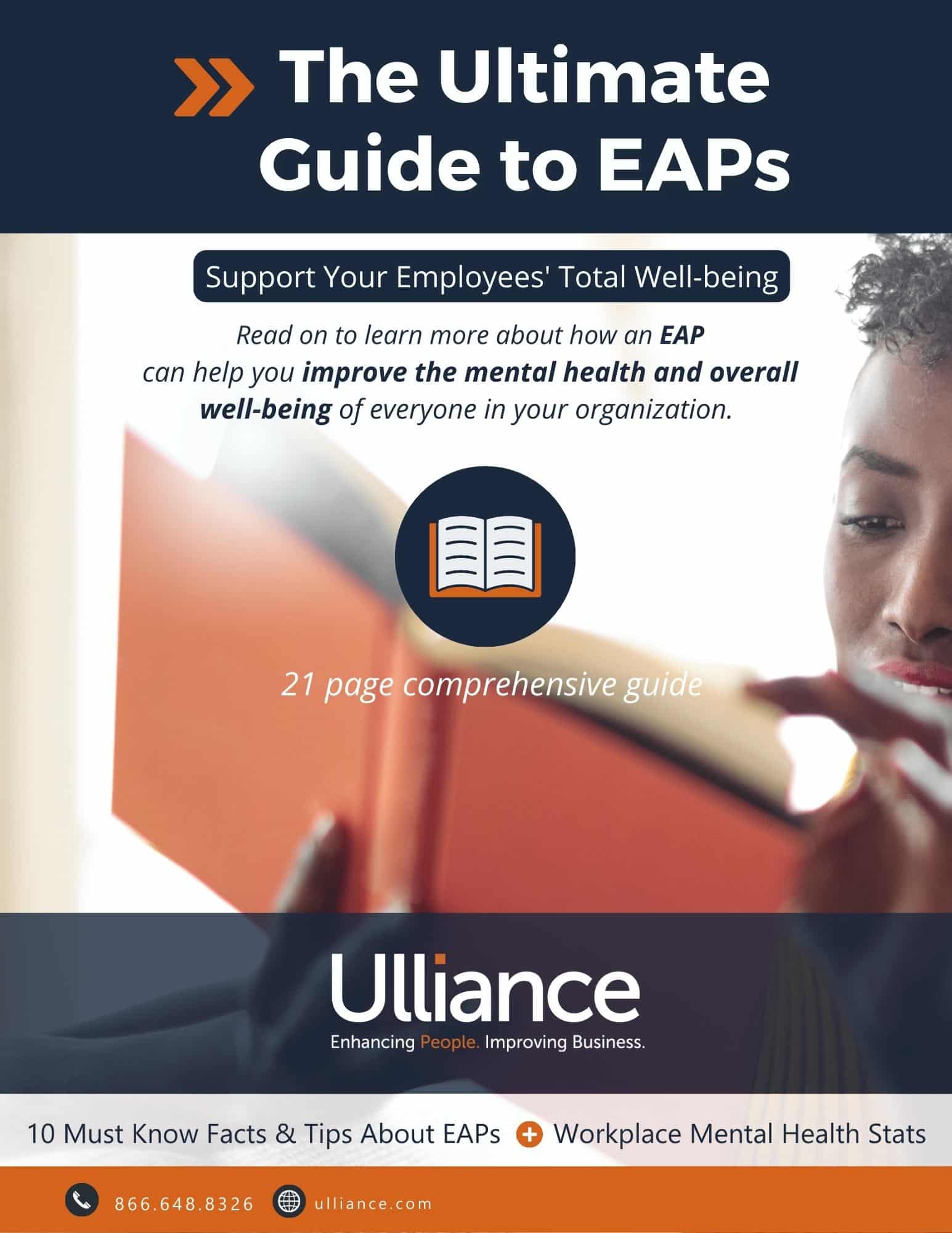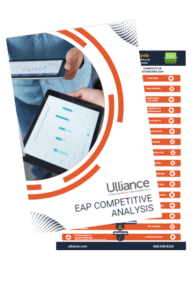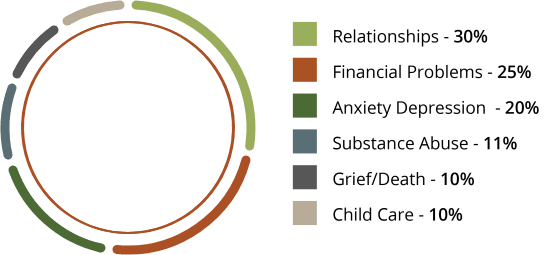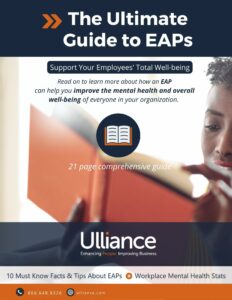The Ultimate Guide to Employee Assistance Programs
Support Your Employees' Emotional Well-being With An EAP
While most companies provide an Employee Assistance Program (EAP) to their workforce, not all EAPS are created equal.
Read on to learn more about how the right EAP resources can help you improve the emotional health and overall well-being of everyone in your organization.
What Is An EAP?
An employer-sponsored employee assistance program (EAP) is a benefit offered to employees to help assess, address and resolve personal issues. EAPs come in all shapes and sizes. They range from no-impact, no-cost, providers to highly-customizable, robust EAPs (which come with a multitude of features and benefits).
The point of offering any EAP is to support your workforce, keep claims costs down, and improve overall productivity by preventing or solving problems quickly, and for good.
Are Employers Required to Provide an EAP for Their Employees?
The short answer is no. EAPs are typically seen as part of the employer's voluntary benefits package, but are not required. Although, they do help employers stay compliant with many health and safety regulations.
A typical EAP might include features like a 24-hour helpline, in-person counseling and well-being programs. Employees who are aware of, and/or utilize their EAP often see it as a high-value benefit. A few of the problems with certain EAPs, as we'll get into below, are under-utilization, and not being resolution-focused.

Why Does Our Company Need An EAP?
Everyone is facing some kind of issue or concern. Whether it's at home, or in the workplace, your employees could be juggling anything from work-related stress to life-threatening addiction. Without proper mental health support, your employees are more likely to lose focus, create safety issues, stop showing up for work, or become less productive.
Workplace wellness programs have the potential to greatly enhance the employee experience and contribute to a stronger bottom line. By implementing these programs effectively, businesses can create a positive work environment that not only supports employee well-being but also leads to increased productivity and profitability.
Workplace total well-being programs can improve the employee experience by promoting a healthier lifestyle. They typically include initiatives such as providing healthy snacks and organizing fitness challenges. By encouraging employees to adopt healthier habits, such as regular exercise and balanced nutrition, businesses can help reduce stress levels, enhance mood, and boost overall well-being. This, in turn, leads to greater job satisfaction and improved employee engagement.
Implementing wellness programs has been proven to enhance productivity levels significantly. When employees are physically and mentally well, they are more likely to perform at their best. By implementing initiatives that support mental health by providing flexible work arrangements and providing a comprehensive EAP, companies can help reduce absenteeism, presenteeism, and burnout among employees. Employees who feel supported in managing their well-being are generally more motivated, focused, and capable of delivering high-quality work, resulting in increased productivity for the organization.
Total well-being programs including employee assistance programs can have a tremendous impact on an organization’s bottom line. Encouraging healthy habits, such as regular exercise, work/life balance, mindfullness and nutritious eating, can help prevent chronic conditions and reduce medical expenses for both employees and employers. Moreover, these wellness initiatives can help attract top talent and improve employee retention, saving recruitment and training costs associated with high turnover rates.
Overall, successful implementation of workplace wellness programs can improve the employee experience and boost the bottom line of businesses. By promoting physical and mental well-being, organizations can create a work environment that fosters happier and more engaged employees, leading to increased productivity and reduced healthcare costs. Investing in these programs not only benefits employees but also contributes to the long-term success and profitability of the company.
HR Professionals Try To Help Employees Solve Problems
Human Resource professionals often try to 'fill the gap' and provide counseling and advice for employees. But that's just a stop-gap for the type of mental health support they need to get well and stay well. Constantly trying to fill that gap is a drain on HR staff, creating yet another layer of people who need support. It can become a vicious cycle of trying to help, but failing to solve the problems for good. Furthermore, HR professionals are not licensed as counsellors and could be exposing themselves or their organizations to potential liability.
Supporting Your Employees With an EAP
Investing in the right EAP to support your employees before, during, and after they face adverse events, will help them and help you. Short and long term benefits of choosing the right EAP include:
- Reduced healthcare claims costs
- Improved compliance with health and safety regulations
- Increased workforce attendance and team performance
- Quicker mitigation of staff issues
- Improved people skills for your managers
- Better utilization of your HR team
Providing an EAP isn't just the"right thing to do." It is a critical tool used to improve organizational health and well-being.

Types of EAPs and EAP Providers
Free or Embedded EAPs
Embedded EAPs, provided as an add-on by many insurance providers, are static, cookie-cutter solutions that prohibit employers from modifying or making model changes throughout the year. They also have slower response times.
In the worst cases, the free or embedded EAPs have shallow features, are not completely confidential, and have less qualified clinicians/providers. In the very worst cases, they carry hidden costs. They become the opposite of 'free.'
Fixed Visit Model
Typically, employees are limited to 3 sessions (1-3) of counseling. EAP models that fail to resolve issues within their programs result in increased behavioral healthcare claims costs.
Stand-Alone EAPs
A stand-alone EAP can be customized to fit your company's needs, is more likely to have a deeper bench of employee benefits, provides more highly qualified clinicians/providers, offers better training and support for HR managers, has higher utilization rates, and delivers a return on investment.
Total Well-being EAP
An EAP that includes physical and mental wellness for total well-being.
What Comes With An EAP?
Free EAPs come with bare bones features like an 1-800 number to report a problem, and maybe a list of counselors for employees to research on their own. This does not typically include access to the providers.
A stand-alone EAP will have more features. Depending on what type of stand-alone EAP you choose, your program could come with common features like:
- 24-hour crisis hotline
- A large network of licensed clinicians
- Some free visits to clinicians
The Ulliance Life Advisor Resolution EAP Model® , one of the most robust in the industry, comes standard with:
- A dedicated EAP Account Manager that provides tools and resources to promote the utilization of your EAP
- A flexible number of employee counseling visits per issue per eligible person
- Telephonic, face-to-face and video counseling
- Unlimited Life Enhancement Coaching to assist in setting and achieving self-improvement goals
- Free Work-Life Resources on a wide variety of topics
- A comprehensive and easy to use Life Advisor Resource Center portal with thousands of well-being resources
- A Working Advantage Discount Program that can provide up to a 60% discount on hotels, theme parks, travel, movies and concerts
- Access to experienced and knowledgeable legal and financial individuals at a discount rate
- Unlimited and free HR and Management consultations on problematic employee and organizational issues
- Unlimited work performance referrals to assist employees in getting "back on track"
- HR Resources, Smart Manager Webinars and podcasts to assist managers in better understanding and handling employee concerns
- Unlimited Critical Incident Stress Debriefings due to a severe accident, natural disaster, employee death, robbery or traumatic event
- Unlimited employee and supervisor orientations to help educate everyone on the valuable resources of the EAP, which in turn, improves utilization
- Complete promotional materials, including welcome letters, posters, brochures, wallet cards, magnets, fliers, and employee and management newsletters
- Balanced Living Workshops, 30 minutes in length, designed to enhance the quality of life and promote EAP services
- Comprehensive and confidential aggregate service reports that provide valuable information on the EAP usage and trends
- 100% Performance Guarantee

See for yourself! Try our ROI calculator—and discover the possible return on investment for your organization.
EAP Costs Per Employee
One of the factors when considering an EAP program for your company is of course—cost.
Today, EAPs come in a variety of models, including pay-per-use, and fixed rate per employee. Prices vary according to number of locations, and which model you choose.
Your free EAP, offered through insurance programs may appear to be free but the costs are hidden in the insurance premiums. With an insurance product embedded EAP, usage is treated like an insurance claim and high utilization equals lost profits. As a result, your employees are often directed to their medical plan for services which could trigger out of pocket expenses for them (co-pays and deductibles). Not to mention higher experience or claims for your company.
Stand alone, customizable EAP programs, initially cost more per employee, but often deliver a greater number of important services and a higher return on investment.
The most important factor to consider when weighing the costs of any EAP, is: will it solve the problem? Utilization rates are absolutely important, but just as important is having a Resolution-Model EAP® that solves employee problems once and for all. The real value of an EAP is that it truly helps your employees and their eligible dependents.
Keep an Eye on Your EAP Usage Rates
It's important to note the direct relationship between EAP utilization rates and an EAP's ROI. Your insurance company may increase or decrease your premiums based on EAP utilization. It's wise to keep an eye on your EAP utilization rates, and then deploy necessary strategies and tactics to increase employee engagement with your EAP to ensure return on investment.
HR departments that are proactively involved with monitoring and leveraging their company's EAP programs see the best value.


How To Choose An EAP For Your Company
Think about your EAP in terms of customization. What would a custom-made EAP look like for your organization? You can help answer this question by conducting an in-house survey of managers and employees to determine the right EAP for your organization.
Ask your managers:
- What are the most common problems faced by our employees?
- What is the average age of our workforce (this would influence whether you need more support for retirement planning or family issues)?
- How many employees do we need to serve?
- If we already have an EAP, what do users value most?
- Is our current EAP delivering what it says it does and what we need?
- Are we seeing value and ROI from our current EAP?
- What are our EAP utilization rates?
Ask your employees:
- Are you aware of the EAP services offered by your current provider?
- What EAP features have employees appreciated from their previous employers?
- If we had a better EAP would you use it?
Ask your potential EAP Providers:
- What are their utilization rates?
- Are utilization reports provided?
- What are their customer satisfaction ratings?
- What features do they offer in their regular EAP that are not at an extra fee?
- What are the costs for the EAP services not included in the regular EAP?
- How easily and quickly can you provide support to someone in need?
- What type of clinicians/providers come with the EAP?
- What support can you provide to our HR team?
- Can you customize the EAP?
To start, it is crucial to have a clear understanding of the type of EAP that best aligns with your organization's needs. Once identified, delve into the market to explore vendors that offer such services. This step helps narrow down your options, ensuring you focus on providers that are relevant and cater to your requirements.
Once you have it narrowed down to a few providers consider:
- All the EAP features are included in the EAP at no additional cost
- Cost per person
- Credentials of clinicians/providers in network and availability in the areas where your business or businesses are located
- Wait times & turnarounds
- Continuing education opportunities like workshops/seminars, etc

How To Implement An EAP
Like any other company-wide program, your EAP will need champions, buy-in from key stakeholders, a solid strategy, goals for ROI, and a strong line of communication to end users.
Look for an EAP program that provides proper training for HR staff, and a communications strategy for your workforce.
Stakeholders and managers aside, the EAP is for the people. It's important to provide a strong line of communication about your EAP program if you want people to actually use it. Consider leveraging social media, newsletters, webinars, lunch and learns, mobile apps, and employee endorsements to spread the word and increase engagement.
Common Questions Your Employees Might Have About Their EAP:
- Is it confidential?
- What will this cost me?
- Is it mandatory that I use it?
- How do I get a hold of them?
Be ready for questions from your workforce to help answer the question: What do I get with my EAP?
When Should We Upgrade Our EAP?
If you're monitoring your EAP and looking at the data, through the service reports provided to confirm that it's delivering what you need, then you've chosen a great plan and provider.
Obviously, it's always better to be proactive than reactive. But it's often only after a disaster or critical incident that many companies take a long, hard look at their EAPs.
If you're trying to get ahead of the curve, consider these common signs that it's time to upgrade your EAP:
- Low utilization rates of your current EAP program
- Low ROI of your current EAP program
- Organizational changes such as corporate mergers, a spike in hiring, layoffs, or a critical event in the workplace
- Poor response times from the provider
- Poor provider network or employees having difficulty scheduling appointments
- No utilization reports
- No account manager or one that does not have a degree/is not credentialed in social work
A Good EAP Pays For Itself
No matter what kind of company you work for, you have a human workforce. And humans bring more to work than just their lunches.
An EAP is a sound investment for companies of all sizes because a good one will pay for itself. With the right EAP you'll increase productivity, and decrease employee turnover--both things that can have a direct impact on the bottomline.







